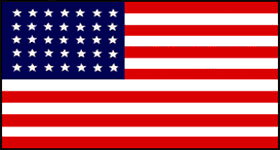 |
Civil War Battles |
|
State War Records |
| AL - AK - AZ - AR - CA - CO - CT - DE - FL - GA - HI - ID - IL - IN - IA - KS - KY - LA - MA - MD - ME - MI - MN - MS - MO - MT - NE - NV - NH - NJ - NM - NY - NC - ND - OH - OK - OR - PA - RI - SC - SD - TN - TX - UT - VT - VA - WA - WV - WI - WY |
The Battle of Dalton (Second)
August 14-15, 1864 in Whitfield County, Georgia
 |
|||||||||||||||||||||
|
Early in August, Gen. John B. Hood, commander of the Confederate forces defending Atlanta, Georgia, was in a strategic predicament. Although he had repulsed attempts by Union cavalry and infantry to break his only remaining supply line, the Macon & Western Railroad, he lacked the strength to drive back Maj. Gen. William T. Sherman's army. It was only a matter of time before the far superior numbers of the Federals would enable them to reach the Macon & Western, thus compelling Hood to evacuate Atlanta.
His solution to this problem was to send Maj. Gen. Joseph Wheeler and his 4,000 cavalrymen on a raid against Sherman's supply line. Hood ordered Wheeler to attack the Western & Atlantic Railroad below Chattanooga, then to strike at the railroads south of Nashville, and finally to return to Atlanta with 2,800 of his men, again hitting the Western & Atlantic as he did so, while leaving the rest of his command in Tennessee to continue operations there. With these railroads out of commision, Sherman's army would be faced with starvation, and either be forced to retreat or make a suidcidal frontal assault on Atlanta's strong fortifications.
Wheeler set out on August 10th. At first he was successful, ripping up more than 30 miles of track near Marietta, Resaca, and Dalton. They approached Dalton in the late afternoon of August 14 and demanded the surrender of the garrison.
The Union commander, Col. Bernard Laibolt, refused to surrender and fighting ensued. Greatly outnumbered, the Union garrison retired to fortifications on a hill outside the town where they successfully held out, although the attack continued until after midnight. Skirmishing continued throughout the night.
Around 5:00 A.M. on the 15th, Wheeler retired and became engaged with relieving infantry and cavalry under Maj. Gen. James B. Steedman's command.
Eventually, Wheeler withdrew. The contending forces' reports vary greatly in describing the fighting, the casualties, and the amount of track and supplies captured and destroyed.
This engagement was inconclusive, but since the Confederates withdrew, it may be termed a Union victory.
Heavy concentrations of Union infantry drove him away from the Western & Atlantic and caused him to ride, contrary to orders, into East Tennessee. From there, he swerved westward, destroyed a few miles of track south of Nashville, then fled into Alabama with his command so exhausted and demoralized that it was not able to resume active operations until October.
The highly efficient Union repair crews speedily restored the tracks destroyed by Wheelr, Sherman's forces suffered no serious supply problems, and Hood was left in an even worse military situation, having in effect thrown away the cream of his cavalry. Yet, given his circumstances, he was justified in ordering the raid, for he had no other card to play in his desperate struggle to hold Atlanta.
